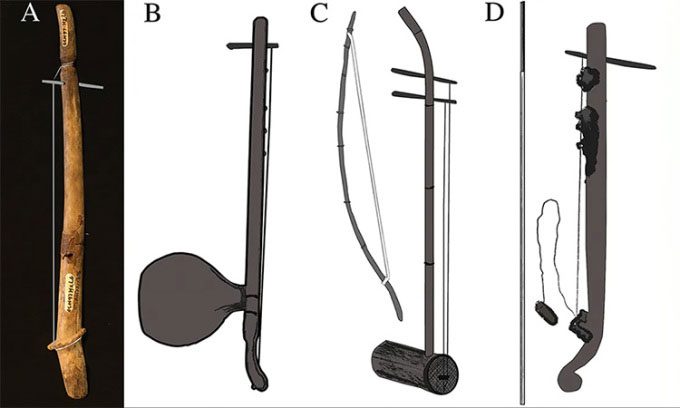A 35cm Long Antler Likely Belonging to a Sambar Deer or a Gold Deer Discovered Along the Mekong River.

Reconstruction of the artifact (A) compared with other Vietnamese instruments such as Bro JoRai (B), dan co ke (C), and dan K’ný (D). (Photo: F Z Campos/Antiquity Journal)
Scientists have discovered an unusual antler fragment at a site along the Mekong River in Vietnam, which may represent one of the oldest string instruments ever excavated in Southeast Asia. It resembles a one-string harp and could be a precursor to the complex instruments still used in Vietnam today. The new study was published in the journal Antiquity on February 21.
The artifact consists of a 35 cm long deer antler with a hole at one end serving as a tuning peg, similar to the frets on a guitar. The string has long since worn away, but the artifact still retains a part known as the bridge, which likely supported the string.
Archaeologists from the Australian National University (ANU) and the Long An Museum describe the artifact in their new study and conclude that it is almost certainly a string instrument played to produce music. “There is no reasonable alternative explanation for its use,” said lead researcher Fredeliza Campos, a PhD candidate at ANU.
The antler likely belongs to a Sambar deer or a Gold deer, two species native to Southeast Asia. The research team has dated the artifact to 2,000 years ago, from the pre-Oc Eo culture of Vietnam along the Mekong River.
“This is one of the oldest examples of this type of string instrument in Southeast Asia. It fills a gap between the oldest recorded instruments in the region – lithophones or stone percussion instruments – and more modern instruments,” Campos added.

Illustration of how ancient people might have played the 2,000-year-old instrument. (Photo: F Z Campos)
To gain a deeper understanding of the musical culture of ancient Vietnam, the research team examined a catalog of over 600 bone artifacts discovered in the area. Their analysis indicates that this unique antler fits well within the catalog, while also highlighting the emergence of other ancient instruments in Vietnam, such as the dan K’ný.
“K’ný is a one-string instrument played with a bow, controlled by the mouth of the player. The instrument can produce a variety of sounds and tones, exceeding the scale typically heard on a piano,” Campos explained.





















































